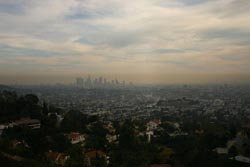Chemistry inside aerosol particles leads to better smog forecasts

A big smog layer is visible over the American mega city Los Angeles.<br>Steve Buss, from flickr <br>
Los Angeles, London, New Delhi or Beijing – all are mega cities in which millions of people suffer from breathing problems and burning eyes. The cause is smog. Often it is so thick that the tops of the skyscrapers disappear and the sun cannot be seen for days.
Under certain weather conditions smog – a mixture of particles and gaseous pollutants like ozone – develops due to traffic, industrial activities, or combustion of biomass, coal and wood. The main component of urban smog is the so-called secondary organic aerosol (SOA). The SOA particles develop from organic compounds oxidized by ozone and hydroxyl radicals. The organic molecules are for example released by burning fossil and renewable fuels.
The processes and mechanisms for the formation of these smog particles are still poorly understood. It has been difficult to accurately predict size and mass of the particles, which determines atmospheric visibility, i.e. the smog thickness and the extent of adverse health effects.
An improved view on smog has now been obtained by a team led by the Max Planck researcher Manabu Shiraiwa. “So far, it is considered that only the gas reactions are important for smog formation,” says Shiraiwa, lead author of a recently published study. “We found out that it is more important what happens inside the particles, which is a typical multiphase reaction and needs to be included in the model forecasts,” adds the 30 years old Japanese scientist, who conducted the study at the California Institute of Technology in the U.S. and who came back to the Max Planck Institute for Chemistry in Mainz in April 2013 where he had working before.
The researchers generated smog which mimicked the urban air in the laboratory. They used the volatile organic molecule dodecane as particle source. Dodecane belongs to the alkanes, which consist only of carbon and hydrogen atoms, and is also emitted into the atmosphere by incomplete combustion of biomass. In a giant special reaction chamber they added hydroxyl radicals (OH) for photooxidation leading to the formation of smog particles. Hydroxyl radicals are a kind of cleaning agent of the atmosphere, which quickly reacts with volatile organic molecules such as methane or alkanes. After the oxidation the researchers measured the size of the SOA particles developed in the chamber. About five hours later they observed a steep increase in mass and size of the particles.
The traditional model however predicts a much slower increase. Shiraiwa and his colleagues concluded that the gase phase reactions are not sufficient enough for the particle growth. Mass spectrometry measurements confirmed that the small volatile organic molecule dodecane reacts to bigger, less volatile organic molecules. As these molecules do not evaporate from the particle phase the particles grow bigger. Since these multiphase reactions have so far never been considered in air quality models the researcher hope that including the findings will lead to better prediction of air quality in the urban air.
Shiraiwa who currently establishes a research group at the Max Planck Institute for Chemistry will continue studying the chemical aging of organic aerosols and related topics. He received his Bachelor and Master degree at the University of Tokyo, and his Ph.D. degree at the Max Planck Institute for Chemistry in Mainz where he developed the kinetic model for the reactions of atmospheric particles. In 2012 he has been awarded the Otto Hahn Medal of the Max Planck Society and Paul Crutzen Prize of German Chemical Society for his path-breaking discoveries about the progression of chemical reactions on the surface of and inside aerosol particles.
Original publication
Size distribution dynamics reveal particle-phase chemistry in organic aerosol formation, Manabu Shiraiwa, Lindsay D. Yee, Katherine A. Schilling, Christine L. Loza, Jill S. Craven, Andreas Zuend, Paul J. Ziemann and John H. Seinfeld
PNAS, 110(29), 11746-11750, doi: 10.1073/pnas.1307501110
Media Contact
More Information:
http://www.mpic.de/All latest news from the category: Life Sciences and Chemistry
Articles and reports from the Life Sciences and chemistry area deal with applied and basic research into modern biology, chemistry and human medicine.
Valuable information can be found on a range of life sciences fields including bacteriology, biochemistry, bionics, bioinformatics, biophysics, biotechnology, genetics, geobotany, human biology, marine biology, microbiology, molecular biology, cellular biology, zoology, bioinorganic chemistry, microchemistry and environmental chemistry.
Newest articles

High-energy-density aqueous battery based on halogen multi-electron transfer
Traditional non-aqueous lithium-ion batteries have a high energy density, but their safety is compromised due to the flammable organic electrolytes they utilize. Aqueous batteries use water as the solvent for…

First-ever combined heart pump and pig kidney transplant
…gives new hope to patient with terminal illness. Surgeons at NYU Langone Health performed the first-ever combined mechanical heart pump and gene-edited pig kidney transplant surgery in a 54-year-old woman…

Biophysics: Testing how well biomarkers work
LMU researchers have developed a method to determine how reliably target proteins can be labeled using super-resolution fluorescence microscopy. Modern microscopy techniques make it possible to examine the inner workings…





















